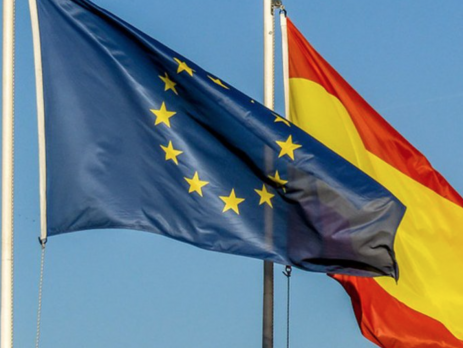Brussels slashes Spain’s growth forecast, projecting slower recovery than EU neighbors
While France is expected to return to pre-pandemic GDP levels by this year, the Spanish economy may not bounce back until the third quarter of 2023
Spain is growing and coming out of the economic crisis caused by the coronavirus pandemic, which saw gross domestic product (GDP) in the country fall by levels not seen since the Spanish Civil War in the late 1930s. But it is doing so at a slower rate than expected, and faces the risk of being left behind by other countries in the euro zone. That’s the situation outlined by the autumn economic forecast released by the European Commission on Thursday. For 2021, Spain is expected to grow 4.6%, 1.6 points below the figure predicted in the summer forecast and 1.9 points below the government’s estimate, upon which next year’s budget plans are based. In 2022, output is projected to rise 5.5%, which is also far below the summer forecast.
The economic crisis of 2020, which was the biggest seen in several generations, is being followed by a strong recovery in the euro zone. “We are maintaining a solid growth path of 4.3% for next year, before falling to 2.5% in 2023,” said Paolo Gentiloni, the European Commissioner for the Economy, at the presentation of the autumn 2021 economic forecast on Thursday. This recovery will allow most countries in the European Union to regain their pre-pandemic output levels this year, said Gentiloni, who is a former prime minister of Italy. According to the forecast, France will bounce back at the end of the year, Germany – whose economy has been harder hit than others by the global supply crisis – will do so at the beginning of 2022, while Italy is projected to reach pre-pandemic GDP by spring. Spain, however, is not forecast to return to this level until the third quarter of 2023.
As for the euro zone, Brussels raised the 2021 growth forecast to 5%, two decimal points up from the summer forecast, but downgraded projected output for 2022 from 4.5% to 4.3% These figures, however, indicate a strong recovery that could have been stronger if not for the supply chain crisis or pick-up in inflation. At the presentation, Gentiloni said that the forecasts were made in a situation of “high uncertainty,” given that “recovery continues to be highly dependent on the evolution of the pandemic, both within and outside the EU.” In the last few weeks, the coronavirus situation has worsened in countries such as Bulgaria, Germany, Austria and the Netherlands, where tighter restrictions have been reintroduced.
The European Commission’s autumn forecasts cut Spain’s projected growth even more than the International Monetary Fund (IMF), which a few weeks ago downgraded the country’s output to 5.7% for 2021 and 6.4% for 2022. Spain’s National Statistics Institute (INE) also released disappointing growth figures at the end of October. All this points to a macroeconomic scenario in which it is fairly clear that it will be nearly impossible for Spain to reach the forecasts upon which the 2022 budget was based.
The autumn forecast, published on Thursday, states that private consumption will be the main driver of Spain’s economic recovery, indicating that this will remain strong “with the impulse of savings accumulated during the pandemic and the recovery of employment.” It adds: “Meanwhile, the implementation of the Recovery and Resilience Plan (RRP) will gain traction, thereby spurring public and private investment.” As was the case with the 2008 financial crisis, the external sector is also projected to contribute positively to GDP “thanks to the gradual normalization of international tourism,” the document states. But, as explained by Gentiloni, weaker than expected performance from the external sector is one of the reasons why Brussels has cut its growth forecast for Spain.
Risk of lagging behind
The problem is this will not be enough to stop Spain from lagging behind its EU neighbors. The situation is compounded by inflation, which in the euro area is projected to peak at 3.7% in the last quarter of the year and “continue recording high prints in the first half of 2022,” according to the autumn forecast. This will no doubt increase the pressure on the European Central Bank (ECB) to withdraw stimulus packages and raise interest rates, which would hurt countries such as Spain, which have a large amount of public debt.
In its autumn forecast, Brussels projects that debt in Spain will remain well above 100% of GDP in the next few years. The country’s deficit is expected to reach 8.1% in 2021, with debt increasing to 120.6% of GDP, up marginally from 120% in 2020. This figure will start to fall in 2022 and 2023, to 118.2% and 116.9%, respectively. This is 20 points higher than the euro zone average and close to 30 points more than the EU as a whole.
The forecast also shows Spain lagging behind in the labor market, an area in which it consistently performs poorly, both in periods of crisis and recovery. Although the situation has improved over the last few months – the number of employed exceeds 20 million for the first time since 2008 – it is starting from a worse position and will continue to do so in the coming years. Unemployment in the EU is forecast to fall to 6.7% in 2022, which is where it was before the pandemic. While in Spain, it is projected to be 14.3%.
This article published here https://english.elpais.com/economy-and-business/2021-11-11/brussels-slashes-spains-growth-forecast-projecting-slower-recovery-than-eu-neighbors.html



